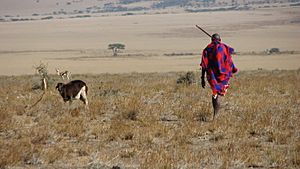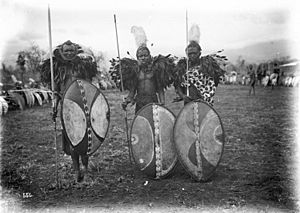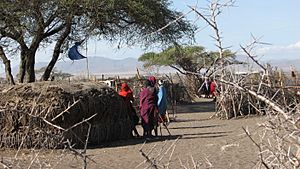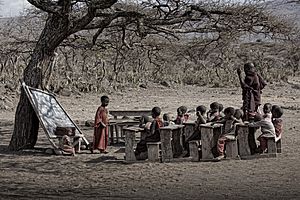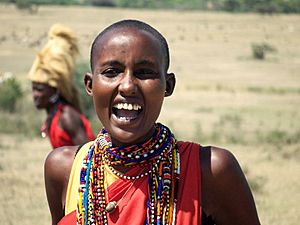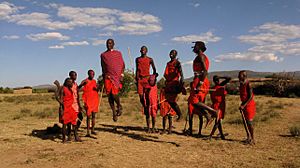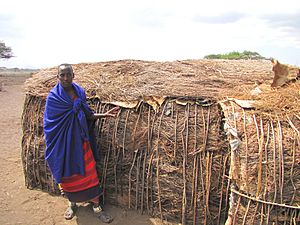Maasai facts for kids
The Maasai are a famous ethnic group of people. They live in Kenya and the northern part of Tanzania. Many people know them for their unique way of dressing. They also live near many popular national parks in Africa that tourists love to visit.
The Maasai speak a special language called Maa. They are an old African tribe, part of the Nilotic group. They have lived in these areas for a very long time. They were first noticed by European settlers around the 1800s.
Maasai people live near the African savannah. This includes famous animal reserves like the Maasai Mara and the Serengeti. Their homes are called Manyatta, and women usually build them. Men build fences around their villages to keep them safe from wild animals like lions.
The Maasai are pastoralists, meaning they live with and depend on animals. Cattle are very important to them. A Maasai man is considered richer if he owns more cattle. Their wealth and way of life come from these animals.
Most Maasai people are Christians or follow their own traditional religion called animism. Some Maasai are also Muslim. They are often described as tall and slim. They love to wear colorful bandannas and beautiful beaded jewelry.
Contents
History of the Maasai People
The Maasai people live in the African Great Lakes region. They arrived there from South Sudan. Many groups in this area, including the Maasai, are pastoralists. This means they raise animals like cattle. They were known as brave warriors and skilled cattle herders.
In the past, the Maasai expanded their territory. They sometimes moved other groups who already lived there. By the mid-1800s, the Maasai controlled a very large area. This included most of the Great Rift Valley. Their land stretched from Mount Marsabit in the north to Dodoma in the south.
Later, some Maasai lands were used to create wildlife reserves. This happened in the 1940s in Tanganyika (now Tanzania). Many national parks were created on their traditional lands. These include Amboseli National Park, Nairobi National Park, and Maasai Mara in Kenya. In Tanzania, parks like Serengeti National Park were also formed.
Maasai Culture and Traditions
The Maasai people believe in one main god. They call this god Enkai or Engai. Engai has two sides: Engai Narok (Black God) is kind, and Engai Na-nyokie (Red God) can be angry.
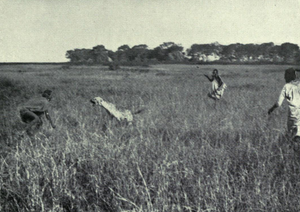
The Maasai also have a special connection with lions. Lions are a totemic animal for them. However, lions can still be hunted if they attack Maasai livestock.
Life with Cattle
The traditional Maasai way of life is centered around their cattle. These animals are their main source of food. A man's wealth is measured by how many cattle and children he has. Having about 50 cattle is considered good. The more children a man has, the better. If a man has many cattle but few children, or vice versa, he is seen as less wealthy.
Cattle provide almost all the food the Maasai need. They eat the meat and drink the milk daily. Sometimes, they also drink the blood of their cattle. For special events, they might slaughter bulls, goats, or lambs for meat. While cattle are very important, some Maasai now also eat foods like sorghum, rice, potatoes, and cabbage.
Lion Hunting
There is a common idea that every young Maasai man must kill a lion to become an adult. This was a tradition in the past. However, lion hunting is now banned in East Africa. Lions are only hunted if they attack Maasai livestock, like cows or goats.
Hair Styles
When a Maasai child is about three months old, they are given a name. Their head is shaved clean, except for a small tuft of hair. This tuft goes from the back of the neck to the forehead.
Only Maasai warriors wear long hair. They braid their hair into thin strands. When warriors become junior elders, they have a big ceremony called Eunoto. During this event, their long hair is shaved off. Elders must keep their hair short.
Music and Dance
Traditional Maasai music uses rhythms from a group of singers. They sing harmonies while a song leader sings the main tune. Unlike many other African tribes, the Maasai often use a deep, continuous sound called a drone in their music.
Women sing lullabies, humming songs, and songs that praise their sons. When many Maasai women gather, they sing and dance together. The Eunoto ceremony, which marks a warrior's coming of age, can include more than ten days of singing, dancing, and special rituals.
Maasai Diet
Traditionally, the Maasai diet included raw meat, fresh milk, honey, and raw blood from their cattle.

Most of the milk they drink is fermented milk or buttermilk. They drink a lot of milk. The Maasai also raise goats and sheep, including the Red Maasai sheep. These are important alongside their more valued cattle.
Fruits are eaten as snacks. They are a big part of the diet for children and women who look after cattle. Warriors in the wilderness also eat a lot of fruit.
Traditional Medicine
The Maasai people often use plants from their environment for medicine. This is because Western treatments can be very expensive. They get medicines from trees, shrubs, stems, and roots. These plant parts can be boiled in soups. They are used to help digestion and clean the blood.
Some remedies can also help prevent or treat diseases. The Maasai also add herbs to their food. This helps avoid stomach upsets and aids digestion. Using plant-based medicine is a very important part of Maasai life.
Maasai Shelter
Maasai Clothing
Maasai clothing shows which ethnic group someone belongs to. It also reflects their pastoralist lifestyle. Clothing and jewelry can also show a person's gender, relationship status, and age. Traditional Maasai clothing helps identify members of the tribe.
In the 1960s, the Maasai started using commercial cotton cloth. Before that, they mostly used animal skins like calf hides and sheep skin.
Shúkà is the Maa word for the sheets they traditionally wear. These are wrapped around the body. They are usually red, sometimes with other colours and patterns. One-piece clothes called kanga are also common. Maasai people near the coast might wear kikoi. This is a sarong-like garment that comes in many different colors and fabrics.
Famous Maasai People
Here are some notable Maasai individuals:
- Joseph Ole Lenku – A former Cabinet Secretary for Interior in Kenya.
- Jackson Ole Sapit - The current Archbishop of the Anglican Church of Kenya.
- David Rudisha – A world-record holder in the 800-meter race.
- Edward Sokoine – A former Prime Minister of Tanzania.
- Edward Lowassa – Another former Prime Minister of Tanzania.
- Olekina Ledama – The founder of Maasai Education Discovery.
- James Ole Kiyiapi – A professor and former permanent secretary in Kenyan ministries.
- Linus Kaikai - A Kenyan journalist and Chair of the Kenya Editors Guild.
- William Ole Ntimama – A former Kenyan politician and leader of the Maa community.
- Francis Ole Kaparo – A former Speaker of the National Assembly of Kenya.
- Joseph Nkaissery – A former Cabinet Secretary for Interior in Kenya.
- Nice Nailantei Lengete – The first woman to speak to the Maasai elders council at Mount Kilimanjaro.
- Katoo Ole Metito – A Member of Parliament in Kenya.
- Mbatian - A prophet after whom Batian Peak, the highest peak of Mount Kenya, is named.


